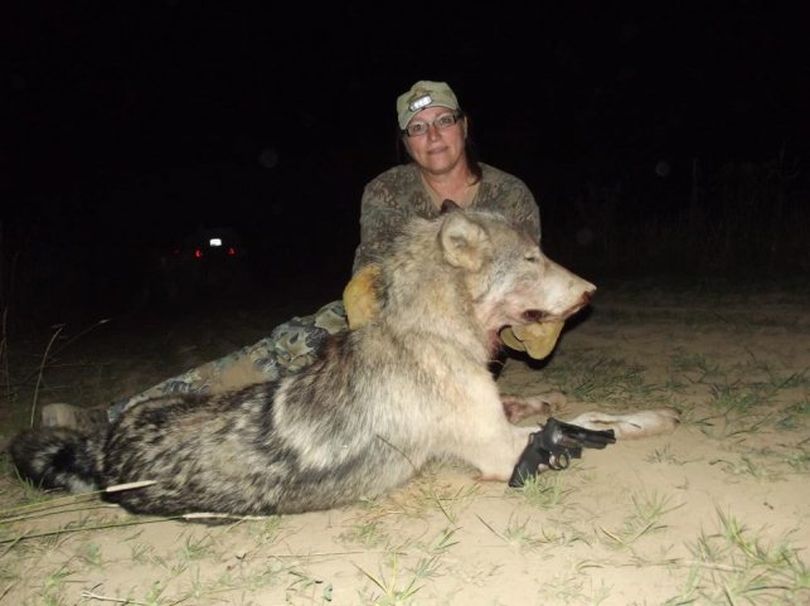Montana wolf seasons closing with higher harvest

PREDATORS -- With Montana's wolf season coming to a close this evening, hunters and trappers have reported killing 223 wolves during the state’s third season and the first that allowed trapping.
That's an increase of 53 over last season's total.
The general rifle wolf season began Oct. 20; trapping opened Dec. 15. Both seasons will be closed Friday.
- See a detaled report from the Flathead Beacon.
- Click "continue reading" below for an updated report from the Associated Press.
IDAHO, which allows hunters to shoot up to five wolves and trap up to five wolves, is in the middle of its second annual hunting season. Hunters and trappers have taken a combined 245 wolves so far in the 2012-2013 seasons (169 by hunters, 76 by trappers). The current season closes March 31.
Feb. 28, 2013
By MATTHEW BROWN/ Associated Press
BILLINGS, Mont. (AP) — With at least 222 gray wolves killed by Montana hunters and trappers during a season that ends Thursday, Gov. Steve Bullock and wildlife officials said they now have the right rules in place as the state seeks to reduce the predator’s population.
Montana’s wolf harvest numbers are up roughly 25 percent from last winter. That’s on top of 104 wolves that were killed by government wildlife agents and ranchers last year due to livestock attacks or other conflicts.
Yet because the animals breed prolifically, Fish, Wildlife and Parks Director Jeff Hagener said he expects at most a modest drop in the population from last year’s estimate of about 650 wolves.
About 400 animals statewide would maintain a sustainable population, he said, but that’s just a rough guideline and not a definitive goal.
Next season could see a sharper population drop, after Bullock on Feb. 13 signed a law that loosened hunting and trapping rules. That came in the wake of pressure from livestock owners and hunters who have pushed for the state to be more aggressive against the animals since wolves lost their endangered species protections two years ago.
Bullock said in an interview this week that the new law gives the state the leeway it needs to effectively manage the animals. It lets hunters take up to three wolves, eliminates no-kill zones around Yellowstone and Glacier National Parks, reduces non-resident hunting fees and allows for electronic calls to lure the animals.
“I think that the bill I signed strikes a reasonable balance, and is an opportunity for us to be able to manage them, but manage them in a way that we don’t get the right to manage taken away from us,” Bullock said.
Wildlife advocates have warned that allowing too many wolves to be killed could again put the gray wolf’s future in peril in Montana, following a two-decade restoration effort that brought the species back from widespread extermination across the Northern Rockies.
In Idaho, where the 2012-2013 wolf season runs through June, hunters and trappers so far have killed at least 245 of the animals.
Hunters in Wyoming killed 43 wolves out of a 52-animal quota during a season that ended Dec. 31. The state took over wolf management just last year after overcoming concerns from federal officials that the state’s management policies would not protect the animals.
Federal officials are monitoring wolves in the three states for five years to determine if endangered species protections should to be reinstated. That could also happen if wildlife advocates successfully petitioned the U.S. Fish and Wildlife Service to intervene.
Bullock and Hagener said that even with the more liberal hunting and trapping rules now in place, Montana wildlife commissioners can step in and rein in wolf killing if needed.
That could include re-imposing quotas in some areas, which were lifted across most of the state last year. Hagener said such limits would make the most sense in areas with relatively few livestock conflicts, such as along the Rocky Mountain Front.
By contrast, more aggressive policies are suited to areas where wolves continue to cause problems even after entire packs have been removed by wildlife control agents, such as around Avon, Phillipsburg and the southern Bitterroot Valley, Hagener said.
“We have some areas where we probably have an overabundance, and other areas where there’s more of a stable number,” he said.
